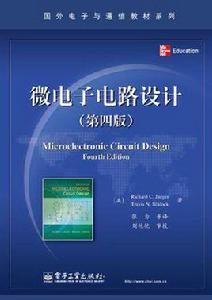內容簡介
第一部分介紹固態電子學與器件,討論了電子學的發展與電路分析方法和微電子器件的工作原理、I-V特性及SPICE模型等。第二部分為數字電路,包括數字電路的基本概念和CMOS電路、存儲電路、ECL與TTL等雙極型邏輯電路以及BiCMOS電路。第三部分為模擬電路,以理想運算放大器和SPICE仿真為基礎介紹了不同結構運算放大器的相關特性、小信號模型、具體分析方法和集成設計技術,最後討論了放大器的頻率回響、反饋和振盪器等問題。通過學習《微電子電路設計(第4版)(英文版)》可以了解現代微電子電路設計,包括模擬與數字,分立與集成,了解內部結構也有利於系統設計中對積體電路的適當選擇。
目錄
Preface xx
PART ONE
SOLID STATE ELECTRONIC AND DEVICES 1
CHAPTER 1 INTRODUCTION TO ELECTRONICS 3
1.1 A Brief History of Electronics:
From Vacuum Tubes to Giga-Scale
Integration 5
1.2 Classification of Electronic Signals 8
1.2.1 Digital Signals 9
1.2.2 Analog Signals 9
1.2.3 A/D and D/A Converters-Bridging the Analog and Digital Domains 10
1.3 Notational Conventions 12
1.4 Problem-Solving Approach 13
1.5 Important Concepts from Circuit Theory 15
1.5.1 Voltage and Current Division 15
1.5.2 Th′
evenin and Norton Circuit Representations 16
1.6 Frequency Spectrum of Electronic
Signals 21
1.7 Amplifiers 22
1.7.1 Ideal Operational Amplifiers 23
1.7.2 Amplifier Frequency Response 25
1.8 Element Variations in Circuit Design 26
1.8.1 Mathematical Modeling of Tolerances 26
1.8.2 Worst-Case Analysis 27
1.8.3 Monte Carlo Analysis 29
1.8.4 Temperature Coefficients 32
1.9 Numeric Precision 34
Summary 34
Key Terms 35
References 36
Additional Reading 36
Problems 37
CHAPTER 2 SOLID-STATE ELECTRONICS 42
2.1 Solid-State Electronic Materials 44
2.2 Covalent Bond Model 45
2.3 Drift Currents and Mobility in
Semiconductors 48
2.3.1 Drift Currents 48
2.3.2 Mobility 49
2.3.3 Velocity Saturation 49
2.4 Resistivity of Intrinsic Silicon 50
2.5 Impurities in Semiconductors 51
2.5.1 Donor Impurities in Silicon 52
2.5.2 Acceptor Impurities in Silicon 52
2.6 Electron and Hole Concentrations in Doped
Semiconductors 52
2.6.1 n-Type Material (ND >NA ) 53
2.6.2 p-Type Material (NA >ND ) 54
2.7 Mobility and Resistivity in Doped
Semiconductors 55
2.8 Diffusion Currents 59
2.9 Total Current 60
2.10 Energy Band Model 61
2.10.1 Electron-Hole Pair Generation in an Intrinsic Semiconductor 61
2.10.2 Energy Band Model for a Doped Semiconductor 62
2.10.3 Compensated Semiconductors 62
2.11 Overview of Integrated Circuit
……
Fabrication 64
Summary 67
Key Terms 68
Reference 69
Additional Reading 69
Important Equations 69
Problems 70

